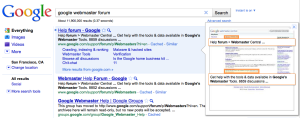Today Google introduced Instant Previews, a new search feature that helps people find information faster by showing a visual preview of each result. Traditionally, elements of the search results like the title, URL, and snippet—the text description in each result—help people determine which results are best for them. Instant Previews achieves the same goal with a visual representation of each page and where the relevant content is, instead of a text description. For our webmaster community, this presents an opportunity to reveal the design of your site and why your page is relevant for a particular query. We’d like to offer some thoughts on how to take advantage of the feature.
First of all, it’s important to understand what the new feature does. When someone clicks on the magnifying glass on any result, a zoomed-out snapshot of the underlying page appears to the right of the results. Orange highlights indicate where highly relevant content on the page is, and text call outs show search terms in context.
Many of you have put a lot of thought and effort into the structure of your sites, the layout of your pages, and the information you provide to visitors. Instant Previews gives people a glimpse into that design and indicates why your pages are relevant to their query. Here are some details about how to make good use of the feature.
- Keep your pages clearly laid out and structured, with a minimum of distractions or extraneous content. This is always good advice, since it improves the experience for visitors, and the simplicity and clarity of your site will be apparent via Instant Previews.
- Try to avoid interstitial pages, ad pop-ups, or other elements that interfere with your content. In some cases, these distracting elements may be picked up in the preview of your page, making the screenshots less attractive.
- Many pages have their previews generated as part of our regular crawl process. Occasionally, we will generate screenshots on the fly when a user needs it, and in these situations we will retrieve information from web pages using a new “Google Web Preview” user-agent.
- Instant Previews does not change our search algorithm or ranking in any way. It’s the same results, in the same order. There is also no change to how clicks are tracked. If a user clicks on the title of a result and visits your site, it will count as a normal click, regardless of whether the result was previewed. Previewing a result, however, doesn’t count as a click by itself.
- Currently, adding the nosnippet meta tag to your pages will cause them to not show a text snippet in our results. Since Instant Previews serves a similar purpose to snippets, pages with the nosnippet tag will also not show previews. However, we encourage you to think carefully about opting out of Instant Previews. Just like regular snippets, previews tend to be helpful to users—in our studies, results which were previewed were more than four times as likely to be clicked on. URLs that have been disallowed in the robots.txt file will also not show Instant Previews.
- Currently, some videos or Flash content in previews appear as a “puzzle piece” icon or a black square. We’re working on rendering these rich content types accurately.
Source: http://googlewebmastercentral.blogspot.com/2010/11/instant-previews.html
